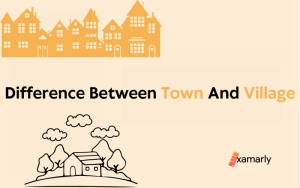Difference between town and village: It’s important to understand the difference between towns and villages when thinking about small communities. The terms ‘town’ and ‘village’ are often used interchangeably, but they do have distinct differences.
In this article we will explore the definitions, characteristics, advantages, disadvantages & the differences between town and village. Read along to know all about these two types of human settlements.
- Difference Between Town And Village: What Is A Town?
- Difference Between Town And Village: What Is A Village?
- Difference Between Town And Village
- Summary
- FAQs Around Difference Between Town And Village
- What is the main difference between town and village?
- Is a village always smaller than a town?
- Can a village become a town?
- Are towns more developed than villages?
- Do people in towns have more job opportunities than people in villages?
- Do towns have a higher cost of living than villages?
- Do towns have more crime than villages?
- Are towns more stressful than villages?
- Are villages better for raising families than towns?
Difference Between Town And Village: What Is A Town?
A town is a settlement that is smaller than cities, but larger than a village. It generally has a local government and a defined boundary. A town usually has a mix of residential, commercial, and industrial areas, and typically has basic urban amenities such as hospitals, schools, and markets.
The population density of a town is usually higher than that of a village. The exact definition & characteristics of a town may vary depending on the country or region. Larger towns with a larger population size gradually become cities.
In India, a town is typically governed by a municipality or a local government body.
Examples Of Towns
- Panaji/Panjim, the capital of the Indian state of Goa: It is a small town situated on the banks of the Mandovi River and is known for its colonial-era architecture, churches, and temples. Panaji has a local government and a defined boundary, and it is home to a variety of residential, commercial, and industrial areas.
- It has basic urban amenities such as hospitals, schools, and markets, as well as a number of tourist attractions like the Goa State Museum and the Church of Our Lady of Immaculate Conception.
- Annapolis, Maryland: It is a historic town located in the United States. It is the capital of the state and home to the United States Naval Academy. Annapolis has a population of around 40,000 and it has a local government and defined boundary.
- It has a mix of residential, commercial, and industrial areas and it has a variety of amenities such as restaurants, shops, parks, and museums. It also has a rich history and many historical buildings, making it a popular tourist destination.
- Guilin, China: It is a town located in the Guangxi Zhuang Autonomous Region in southern China. It is known for its picturesque landscape of karst hills and winding rivers. Guilin has a population of around 6.5 million people, it has a local government and defined boundary.
- It has a mix of residential, commercial, and industrial areas and it has a variety of amenities such as hospitals, schools, markets and tourist spots like Elephant Trunk Hill and Reed Flute Cave.
Characteristics Of A Town
- Local government and defined boundary: It has its own local government, such as a town council or municipality, and has a defined boundary that separates it from surrounding areas.
- Population density: The population density is usually higher and the population is generally more concentrated in a specific area.
- Residential, commercial, and industrial areas: A mix of residential, commercial, and industrial areas, with homes, businesses, and factories located in close proximity to one another.
- Basic urban amenities: Such as hospitals, schools, and markets, as well as public transportation systems and access to utilities such as electricity and water.
- Economic activity: They are usually centers of economic activity, with a wide range of businesses and industries providing employment opportunities for residents.
- Cultural and recreational facilities: They often have cultural and recreational facilities such as libraries, museums, parks, and sports facilities.
- Infrastructure and public services: They have well-developed infrastructure and a variety of public services such as police and fire departments, waste management and emergency services.
- Community identity: They often have a distinct sense of community and identity, with a variety of social and cultural organizations and events that bring residents together.
- Diversity: They tend to be diverse, with a mix of different cultures, backgrounds, and ages among its residents.
- History: Many of them have a rich history, with historical buildings, landmarks, and cultural heritage that reflect the area’s past and its development.
Advantages Of A Town
- Access to amenities and services.
- Better economic opportunities.
- Cultural and recreational facilities.
- Better infrastructure.
- Improved safety and security.
- Quality education opportunities.
- Strong community spirit.
- Healthier environment than a City.
- Access to culture and history.
Disadvantages Of A Town
- Traffic and congestion: Towns can experience traffic congestion and parking difficulties, due to a high volume of vehicles on the roads.
- Noise & Air pollution: They can experience higher levels of noise & air pollution, due to a higher concentration of people and vehicles.
- Overcrowding: These can become overcrowded, leading to a lack of privacy and green spaces.
- Increased cost of living: The cost of living can be higher than in rural areas, due to higher property values and taxes.
- Limited green spaces: They often have limited green spaces, such as parks and gardens, compared to rural areas.
- Crime rates: They can have higher crime rates, due to a higher concentration of people and a greater diversity of socio-economic backgrounds.
- Lack of privacy: They can offer less privacy, as people live in close proximity to one another and there are more people around.
- Stressful environment: They can be stressful environments due to the fast-paced lifestyle and the high population density.
- Limited sense of community: Despite the presence of community organizations and events, these can lack a strong sense of community due to the fast-paced lifestyle and the high population density.
Difference Between Town And Village: What Is A Village?
A village is a small, rural community/settlement that is typically smaller and less populated than a town. It is a human settlement that is usually characterized by a close-knit community and a strong sense of tradition and community.
Villages are typically agricultural communities, with the majority of residents engaged in farming or other rural activities. They often have a small population, a limited number of amenities and services, and a slower pace of life compared to towns and cities.
Villages with larger population size gradually become Towns.
The definition of a village can vary depending on the country or region, but it generally refers to a small, rural community with a distinct sense of community and identity.
Examples Of Villages
- Murs, France: It is a small village located in the Provence region of southern France. With a population of around 800 people, Murs is a traditional agricultural village, known for its picturesque setting among the vineyards of the Côtes du Rhône wine region.
- It has a small number of amenities, including a church, a school, and a few small shops and restaurants. The villagers are closely knit, and the village has a strong sense of tradition and community. It is surrounded by nature and the residents often engage in farming, fishing, and hunting.
- Tambunan, Malaysia: It is a small village located in the state of Sabah in Borneo. It has a population of around 3,000 people and is primarily inhabited by the Dusun ethnic group.
- It is known for its traditional customs and way of life, with many residents still engaged in subsistence farming, hunting and fishing. It also has a small number of basic amenities, such as a school and a health clinic, but the residents rely mostly on their own resources.
- Tambunan is a popular tourist destination, known for its beautiful mountain scenery and traditional culture.
- Yorda, Russia: It is a small village located in the Ural Mountains. It has a population of around 500 people, and is primarily inhabited by the Bashkir ethnic group.
- It is known for its traditional customs, with many residents still engaged in subsistence farming and hunting. The village has a small number of basic amenities, such as a school, a health clinic, and a small store.
- It is surrounded by dense forest, and the residents often rely on hunting, fishing, and gathering wild berries and mushrooms for sustenance.
Characteristics Of A Village
- Small population: These typically have a small population, with a few hundred to a few thousand people.
- Rural location: They are typically located in rural areas, away from urban centers.
- Agriculture-based economy: These are often agricultural communities, with the majority of residents engaged in farming or other rural activities.
- Limited amenities and services: They usually have a limited number of amenities and services, such as schools, healthcare facilities, and shops, compared to towns and cities.
- Strong sense of community and tradition: Villages often have a close-knit community and a strong sense of tradition and community.
- Slower pace of life: These settlements typically have a slower pace of life than towns and cities, with fewer people and less hustle and bustle.
- Natural surroundings: They are often surrounded by nature and the residents often engage in activities like farming, fishing, and hunting.
- Traditional culture: They often have a traditional culture, with customs and practices that have been passed down for generations.
- Less anonymous: They tend to be less anonymous than towns and cities, with residents knowing one another and having a sense of familiarity.
- Economic challenges: They often face economic challenges, with limited job opportunities and a reliance on agriculture and other traditional industries.
Advantages Of A Village
- Slower pace of life: more relaxing and less stressful for residents.
- Strong sense of community: provide a sense of belonging and support for residents.
- Traditional culture.
- Fresh air and less pollution: lead to better air quality and overall health for residents.
- Low crime rates: provide a safer living environment for residents.
- Low cost of living: due to lower property values and taxes.
- Sense of privacy.
- Access to agriculture.
Disadvantages Of A Village
- Limited amenities and services.
- Limited job opportunities.
- Physical & social isolation.
- Limited cultural diversity.
- Lack of nightlife and entertainment.
- Limited access to healthcare & education.
- Limited access to technology.
Difference Between Town And Village
The major difference between town and village exist in terms of their sizes, population, amenities & quality of life.
A town is typically larger than a village and has more developed infrastructure and public services. Villages are generally more rural and have a smaller population. Towns often have a wider range of shops and amenities, and may serve as a regional center for surrounding villages.
Additionally, towns may have a mayor and a town council as opposed to a village, which may have a village chairman or board. However, the difference between town and village can vary depending on the country or region.
| Factors | Town | Village |
|---|---|---|
| Population | High | Low |
| Density | High | Low |
| Urbanization | High | Low |
| Infrastructure | Advanced | Basic |
| Transportation | Convenient | Limited |
| Employment Opportunities | Variety | Limited |
| Industries | Diverse | Agricultural |
| Housing | Diverse | Traditional |
| Education | Advanced | Basic |
| Healthcare | Advanced | Basic |
| Shopping | Variety | Limited |
| Entertainment | Variety | Limited |
| Crime rate | Higher | Lower |
| Pollution | High | Low |
| Green spaces | Less | More |
| Cost of living | High | Low |
| Cultural diversity | High | Low |
| Political representation | High | Low |
| Services | Advanced | Basic |
| Recreation | Variety | Limited |
| Community | Less | Strong |
| Traditions | Few | Many |
| Privacy | Less | More |
| Noise level | High | Low |
| Stress level | High | Low |
Note: The above table is a general comparison of differences between town & village and there may be variations based on the location and country.
Other Articles In The Series:
Summary
Winding up, we learn that although the difference between town and village forms a huge gap but in modern India, this gap is slowly filling up. Villages today, are competing at various levels & aspects with larger towns.
The differences between town and village do not assert any kind of dominance of any one over the other. They are just for our understanding & knowledge of the strengths of both.
FAQs Around Difference Between Town And Village
What is the main difference between town and village?
The main difference is population density, urbanization, infrastructure, transportation, and amenities. Towns generally have a higher population density, more advanced infrastructure and amenities, and better transportation options than villages.
Is a village always smaller than a town?
Not always. The size of a village or town can vary depending on the location and country. Some villages may have a larger population and more amenities than some towns.
Can a village become a town?
Yes, a village can become a town if it meets certain criteria such as population size, infrastructure, and amenities.
Are towns more developed than villages?
In general, towns tend to be more developed than villages, with more advanced infrastructure and amenities. However, this can vary depending on the location and country.
Do people in towns have more job opportunities than people in villages?
In general, towns tend to have more diverse employment opportunities than villages, which are often primarily agricultural.
Do towns have a higher cost of living than villages?
In general, towns tend to have a higher cost of living than villages.
Do towns have more crime than villages?
In general, towns tend to have higher crime rates than villages.
Are towns more stressful than villages?
In general, towns tend to have a higher stress level than villages.
Are villages better for raising families than towns?
It can vary depending on individual preferences. Villages tend to have a stronger sense of community, more traditional values and customs, more privacy, lower noise level, and lower stress level which some people may prefer for raising families.






